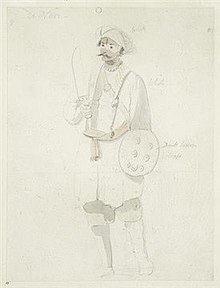 A Nair by Thomas Daniell. Drawn in pencil and watercolor sometime between the 17th and 18th century. | |
| Regions with significant populations | |
|---|---|
| Kerala | |
| Languages | |
| Malayalam,[1] Sanskrit[1] | |
| Religion | |
| Hinduism |
The Nair (/ˈnaɪər/, Malayalam: [n̪aːjɐr]) also known as Nayar, are a group of Indian Hindu castes, described by anthropologist Kathleen Gough as "not a unitary group but a named category of castes". The Nair include several castes and many subdivisions, not all of whom historically bore the name 'Nair'.[2][3] These people lived, and many continue to live, in the area which is now the Indian state of Kerala. Their internal caste behaviours and systems are markedly different between the people in the northern and southern sections of the area, although there is not very much reliable information on those inhabiting the north.[4]
Historically, Nairs lived in large family units called tharavads that housed descendants of one common female ancestor. These family units along with their unusual marriage customs, which are no longer practiced, have been much studied. Although the detail varied from one region to the next, the main points of interest to researchers of Nair marriage customs were the existence of two particular rituals—the pre-pubertal thalikettu kalyanam and the later sambandam—and the practice of polygamy in some areas. Some Nair women also practiced hypergamy with Nambudiri Brahmins from the Malabar region.
The Nair were historically involved in military conflicts in the region. Following hostilities between the Nair and the British in 1809, the British limited Nair participation in the British Indian Army. After India's independence, the Nair Brigade of the Travancore State Force was merged into the Indian Army and became a part of the 9th Battalion, Madras Regiment, the oldest battalion in the Indian Army.
The serpent is worshipped by Nair families as a guardian of the clan. The worship of snakes, a Dravidian custom,[5] is so prevalent in the area that one anthropologist notes: "In no part of the world is snake worship more general than in Kerala."[6] Serpent groves were found in the southwestern corner of nearly every Nair compound.[7]
- ^ a b Goody 1975, p. 132.
- ^ Gough (1961), p. 312
- ^ Fuller (1975) p. 309
- ^ Fuller (1975) p. 284
- ^ K. Balachandran Nayar (1974). In quest of Kerala. Accent Publications. p. 85. Retrieved 3 June 2011.
The Dravidian people of Kerala were serpent worshippers.
- ^ L. A. Krishna Iyer (1968). Social history of Kerala. Book Centre Publications. p. 104. Retrieved 3 June 2011.
- ^ K. R. Subramanian; K. R. Subramanian (M.A.) (1985) [1929]. The origin of Saivism and its history in the Tamil land (Reprinted ed.). Asian Educational Services. pp. 15–. ISBN 978-81-206-0144-4. Retrieved 3 June 2011.